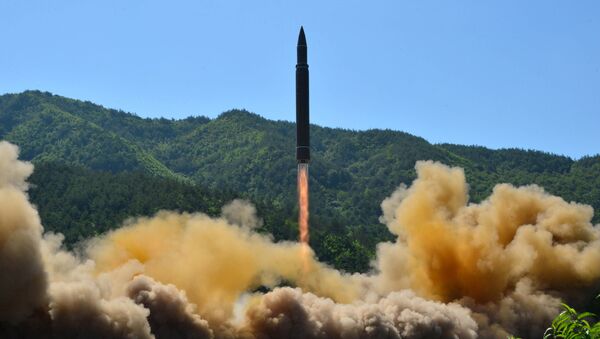Sue Mi Terry, a senior fellow at the Center for Strategic and International Studies (CSIS) and former senior analyst on North Korea for the CIA, participated in the CSIS’ virtual North Korea policy forum on September 24 and expressed doubt about a possible “October surprise” from Pyongyang “because this is an unusual election year where Kim wants to see Trump be elected.”
“So I think that provocation will come, probably, during the transition period,” she said, highlighting the period from November 3 to January 10 as a likely time frame for the Democratic People’s Republic of Korea’s (DPRK) resumption of advanced weapon systems testing.
Terry noted that the provocation could come after January 10 if Democratic nominee and former Vice President Joe Biden wins the upcoming US presidential election.
The world recently got a peek into Trump and Kim’s relationship via Washington Post associate editor Bob Woodward’s book “Rage.”
“I cannot forget that moment of history when I firmly held Your Excellency’s hand,” the North Korean leader said in a letter to his US counterpart on December 25, 2018.

“The only two leaders who can do it are you and me,” said Trump in response to Kim.
Citing the US president’s recollection of events leading up to the summit between Trump and Kim in Singapore in June 2018, Woodward wrote that “for the first year of the Trump presidency, [then-Secretary of Defense James] Mattis had been living on permanent alert” over Pyongyang’s repeated ballistic missile tests, which included a firing of the Hwasong-15 intercontinental ballistic missile. The DPRK conducted at least 21 test launches in 2017 alone.
Trump, who took a hard stance against North Korea in 2017, conceded to Woodward in a recorded interview that Pyongyang and Washington almost engaged in a war.
Despite the historic nature of the Singapore summit, US-North Korea negotiations regarding denuclearization have since fallen apart, without a firm commitment from Kim.
“There was the willingness to engage at the high level, but then it kind of crumbled from there,” explained John Delury, a professor at Yonsei University in Seoul, South Korea, to the Washington Post. “Trump’s chaotic and distracted theatrics of politics meant that it didn’t really create a lasting process.”
Pyongyang also refused to allow Washington to inspect its weapons bunkers.
"North Korea hasn't stopped building nuclear weapons or developing missiles systems; they've just stopped displaying them," said Jeffrey Lewis, director of the East Asia Nonproliferation Program at the Center for Nonproliferation Studies (CNS), to the Post. "They stopped doing the things that made bad news cycles for Trump."
Satellite imagery of North Korea’s Pyongsan Uranium Concentrate Plant indicate that the plant is not only active and operational but is also being readied for increased yellowcake production. Learn more about its infrastructure development: https://t.co/QaFLKMjbaw pic.twitter.com/1fjp2U6wSU
— CSIS (@CSIS) August 30, 2020
The CNS, located in Monterey, California, at the Middlebury Institute of International Studies, is the US’ largest nongovernmental organization “devoted exclusively to research and training on nonproliferation issues,” according to the center’s website.
A confidential version of the United Nations Security Council’s (UNSC) North Korea sanctions committee’s interim report suggested in early August that Pyongyang has “probably developed miniaturized nuclear devices to fit into the warheads of its ballistic missiles.”
“The Democratic People’s Republic of Korea is continuing its nuclear program, including the production of highly enriched uranium and construction of an experimental light water reactor,” the report contended.
The panel issued the full midterm report on Monday, accusing Pyongyang of exceeding its annual 500,000-barrel import limit for refined petroleum products within the first five months of 2020.
The 15-member UNSC panel claimed that satellite imagery of the DPRK showed that Pyongyang temporarily suspended coal exports in late January and resumed deliveries in late March. Experts detailed “ship-to-ship transfers” were made by North Korean vessels operating in “waters of another member state.”
China and Russia questioned the basis for the panel’s assertions in the interim report. Moscow contended the UNSC panel’s issuance “does not provide objective, accurate and verifiable information or have enough solid imagery evidence.”


